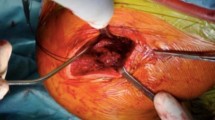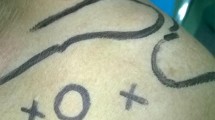Abstract
Background
The debate about the ideal surgical procedure for acromioclavicular joint (ACJ) dislocation is still unresolved and newer techniques are being evolved continuously. The present study evaluates functional outcome of ACJ reconstruction using the modified Weaver Dunn procedure
Materials and Methods
35 patients (26 males, 9 females) with ACJ dislocation, between the age group of 18–48 years (mean age 31 years), were operated using modified Weaver Dunn procedure at our center from May 2005 to June 2010. The dominant side was involved in 25 patients (22 right, 13 left). The mean period from the time of injury to the surgery was 14 days (range 4–26 days). All the patients were assessed with Oxford shoulder score and the time required to return to preinjury level was recorded
Results
At the mean followup of 95 months (range 72–120 months), the mean Oxford Shoulder Score improved from 25 ± 7.2 to 43 ± 6.9. 85% (30 out of 35) patients had satisfactory results, while 15% (5 out of 35) had mild shoulder dysfunction using this scoring system. Five patients had radiological evidence of Grade 2 ACJ subluxation. Out of these five patients, two developed ossification around the coracoclavicular ligament. Three patients had intermittent mild pain without any functional disability, and one had a moderate restriction of shoulder movements
Conclusion
ACJ reconstruction, using the modified Weaver Dunn procedure in ACJ dislocation, is a reproducible procedure and provides a good functional outcome
Similar content being viewed by others
References
Beim GM. Acromioclavicular joint injuries. J Athl Train 2000;35:261–7.
Carofino BC, Mazzocca AD. The anatomic coracoclavicular ligament reconstruction: Surgical technique and indications. J Shoulder Elbow Surg 2010;19:37–46.
Trainer G, Arciero RA, Mazzocca AD. Practical management of grade III acromioclavicular separations. Clin J Sport Med 2008;18:162–6.
Luis GE, Yong CK, Singh DA, Sengupta S, Choon DS. Acromioclavicular joint dislocation: A comparative biomechanical study of the palmaris-longus tendon graft reconstruction with other augmentative methods in cadaveric models. J Orthop Surg Res 2007;2:22.
Rockwood CA Jr., Williams GR, Young DC. Injuries to the acromioclavicular joint. In: Rockwood CA Jr., Green DP, Bucholz RW, editors. Rockwood and Green’s Fractures in adults. 4th ed. Philadelphia: Lippincott-Raven; 1996. p. 1341–407.
Mumford EB. Acromioclavicular dislocation. J Bone Joint Surg Am 1941;23:799–802.
Weaver JK, Dunn HK. Treatment of acromioclavicular injuries, especially complete acromioclavicular separation. J Bone Joint Surg Am 1972;54:1187–94.
Rokito AS, Oh YH, Zuckerman JD. Modified Weaver-Dunn procedure for acromioclavicular joint dislocations. Orthopedics 2004;27:21–8.
Jeon IH, Dewnany G, Hartley R, Neumann L, Wallace WA. Chronic acromioclavicular separation: The medium term results of coracoclavicular ligament reconstruction using braided polyester prosthetic ligament. Injury 2007;38:1247–53.
Beitzel K, Cote MP, Apostolakos J, Solovyova O, Judson CH, Ziegler CG, et al. Current concepts in the treatment of acromioclavicular joint dislocations. Arthroscopy 2013;29:387–97.
Salzmann GM, Walz L, Buchmann S, Glabgly P, Venjakob A, Imhoff AB, et al. Arthroscopically assisted 2-bundle anatomical reduction of acute acromioclavicular joint separations. Am J Sports Med 2010;38:1179–87.
Porschke F, Schnetzke M, Aytac S, Studier-Fischer S, Gruetzner PA, Guehring T, et al. Sports activity after anatomic acromioclavicular joint stabilisation with flip-button technique. Knee Surg Sports Traumatol Arthrosc 2017;25:1995–2003.
Takase K, Yamamoto K. Arthroscopic procedures and therapeutic results of anatomical reconstruction of the coracoclavicular ligaments for acromioclavicular joint dislocation. Orthop Traumatol Surg Res 2016;102:583–7.
Hegazy G, Safwat H, Seddik M, Al-Shal EA, Al-Sebai I, Negm M, et al. Modified Weaver-Dunn procedure versus the use of semitendinosus autogenous tendon graft for acromioclavicular joint reconstruction. Open Orthop J 2016;10:166–78.
Gupta P, Kansal G, Srivastav S, Agarwal S. Arthroscopic fixation using TightRope device for acute acromioclavicular joint disruptions. J Arthrosc Joint Surg 2016;3:7–12.
Gupta R. Editorial. J Arthrosc Joint Surg 2016;3:1–2.
Kumar V, Garg S, Elzein I, Lawrence T, Manning P, Wallace WA, et al. Modified Weaver-Dunn procedure versus the use of a synthetic ligament for acromioclavicular joint reconstruction. J Orthop Surg (Hong Kong) 2014;22:199–203.
Bircher HP, Jülke M, Thür C. Reconstruction of chronic symptomatic acromioclavicular joint dislocation (Rockwood III-V) using the modified Weaver-Dunn method 24 operated patients (1988–1995), surgical technique, results. Swiss Surg 1996;(2):46–50.
Pavlik A, Csépai D, Hidas P. Surgical treatment of chronic acromioclavicular joint dislocation by modified Weaver-Dunn procedure. Knee Surg Sports Traumatol Arthrosc 2001;9:307–12.
Chaudhary D, Jain V, Joshi D, Jain JK, Goyal A, Mehta N, et al. Arthroscopic fixation for acute acromioclavicular joint disruption using the TightRope device. J Orthop Surg (Hong Kong) 2015;23:309–14.
Dawson J, Fitzpatrick R, Carr A. Questionnaire on the perceptions of patients about shoulder surgery. J Bone Joint Surg Br 1996;78:593–600.
Mazzocca AD, Arciero RA, Bicos J. Evaluation and treatment of acromioclavicular joint injuries. Am J Sports Med 2007;35:316–29.
Lemos MJ. The evaluation and treatment of the injured acromioclavicular joint in athletes. Am J Sports Med 1998;26:137–44.
Pallis M, Cameron KL, Svoboda SJ, Owens BD. Epidemiology of acromioclavicular joint injury in young athletes. Am J Sports Med 2012;40:2072–7.
Thomas K, Litsky A, Jones G, Bishop JY. Biomechanical comparison of coracoclavicular reconstructive techniques. Am J Sports Med 2011;39:804–10.
Spencer HT, Hsu L, Sodl J, Arianjam A, Yian EH. Radiographic failure and rates of re-operation after acromioclavicular joint reconstruction: A comparison of surgical techniques. Bone Joint J 2016;98-B:512–8.
Norrell H Jr., Llewellyn RC. Migration of a threaded Steinmann pin from an acromioclavicular joint into the spinal canal. A case report. J Bone Joint Surg Am 1965;47:1024–6.
Mazet RJ. Migration of a Kirschner-wire from the shoulder region into the lung: Report of two cases. J Bone Joint Surg 1943;25:477–83.
Sim E, Schwarz N, Höcker K, Berzlanovich A. Repair of complete acromioclavicular separations using the acromioclavicular-hook plate. Clin Orthop Relat Res 1995;(314):134–42.
Wellmann M, Zantop T, Petersen W. Minimally invasive coracoclavicular ligament augmentation with a flip button/polydioxanone repair for treatment of total acromioclavicular joint dislocation. Arthroscopy 2007;23:1132. e1–5.
Thiel E, Mutnal A, Gilot GJ. Surgical outcome following arthroscopic fixation of acromioclavicular joint disruption with the tightrope device. Orthopedics 2011;34:267–74.
Mazzocca AD, Santangelo SA, Johnson ST, Rios CG, Dumonski ML, Arciero RA, et al. A biomechanical evaluation of an anatomical coracoclavicular ligament reconstruction. Am J Sports Med 2006;34:236–46.
Gangary SK, Meena S. Arthroscopic stabilization of acute acromioclavicular joint dislocation with tightrope AC system: A tale of failures. J Arthrosc Joint Surg 2016;3:13–6.
Faggiani M, Vasario GP, Mattei L, Calò MJ, Castoldi F. Comparing mini-open and arthroscopic acromioclavicular joint repair: Functional results and return to sport. Musculoskelet Surg 2016;100:187–91.
Wright J, Osarumwense D, Ismail F, Umebuani Y, Orakwe S. Stabilisation for the disrupted acromioclavicular joint using a braided polyester prosthetic ligament. J Orthop Surg (Hong Kong) 2015;23:223–8.
Author information
Authors and Affiliations
Corresponding author
Rights and permissions
About this article
Cite this article
Gupta, R., Sood, M., Malhotra, A. et al. Functional Outcome of Modified Weaver Dunn Technique for Acromioclavicular Joint Dislocation. IJOO 52, 418–422 (2018). https://doi.org/10.4103/ortho.IJOrtho_469_16
Published:
Issue Date:
DOI: https://doi.org/10.4103/ortho.IJOrtho_469_16




